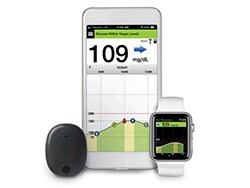June 21, 2018
nn
n
n
 n
n
The device consists of a fluorescence-based sensor that is implanted subcutaneously in the upper arm by a physician in a short office procedure, a transmitter worn above the sensor, and a mobile app that displays glucose values and trends and that issues alerts to high and low blood glucose values. The transmitter also issues on-body vibration alerts.
nn
nIn contrast to current continuous glucose monitors (CGMs) that need to be replaced every 7 to 14 days (typically by patients themselves or caregivers), the Eversense lasts up to 3 months, after which it must be removed in another short office procedure — again by a physician — and replaced on the opposite upper arm.nnThe Eversense is indicated for adjunctive use, meaning the user still needs to perform fingerstick monitoring for treatment decisions, as well twice-daily calibrations, unlike some other CGMs on the US market.nnBut the implantation and the long duration of use are aimed at improving patient acceptance of CGMs and increasing the proportion of patients with type 1 diabetes who use the devices, currently only about 25%.nn “Research has repeatedly demonstrated the clinical benefits patients experience with regular CGM use, including improved glucose control and protection against severe hypoglycemia,” said Steven Edelman, MD, professor of medicine at the University of California, San Diego, in a company statement. “Despite these benefits, a significant number of people with diabetes do not use, or have access to, continuous glucose monitoring.”nnOn March 29 this year, members of the FDA’s Clinical Chemistry and Clinical Toxicology Devices Panel voted 8 to 0 with no abstentions for safety, efficacy, and positive benefit/risk for the Eversense. The vote was based on data from the pivotal PRECISE II study, which involved 90 patients with type 1 or type 2 diabetes at eight US centers. Through 90 days, the system performed with an absolute mean relative difference of 8.5% compared with laboratory reference glucose values. The system detected 96% of hypoglycemic excursions and 98% of hyperglycemic excursions, and 91% of the sensors functioned for the entire 90 days.n
“Research has repeatedly demonstrated the clinical benefits patients experience with regular CGM use, including improved glucose control and protection against severe hypoglycemia,” said Steven Edelman, MD, professor of medicine at the University of California, San Diego, in a company statement. “Despite these benefits, a significant number of people with diabetes do not use, or have access to, continuous glucose monitoring.”nnOn March 29 this year, members of the FDA’s Clinical Chemistry and Clinical Toxicology Devices Panel voted 8 to 0 with no abstentions for safety, efficacy, and positive benefit/risk for the Eversense. The vote was based on data from the pivotal PRECISE II study, which involved 90 patients with type 1 or type 2 diabetes at eight US centers. Through 90 days, the system performed with an absolute mean relative difference of 8.5% compared with laboratory reference glucose values. The system detected 96% of hypoglycemic excursions and 98% of hyperglycemic excursions, and 91% of the sensors functioned for the entire 90 days.n
n
n
nSenseonics made some revisions to the product design for safety reasons following PRECISE II, and the current device was tested in only 35 patients in another trial. However, the system has been approved in Europe since May 2016 and users there are being followed in a registry. At the hearing, the FDA advisory panel recommended that the same be done in the United States.nnAlso at the FDA committee meeting, Seneonics presented its plan for training physicians on how to insert and remove the sensors. Trial investigator Steven J. Russell, MD, from Harvard Medical School in Boston, Massachusetts, said that it was easy to learn and also commented that, as a diabetes-focused endocrinologist, “it’s nice to do procedures again.”n
n
n
n
n
n
n


